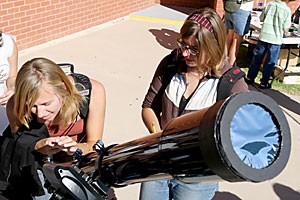From down here, it just looks like someone poked a tiny hole in the side of a red balloon.
But the planet Mercury only passes in front of the sun about 13 times a century, said Mike Terenzoni, planetarium coordinator for Flandrau Science Center and Planetarium.
The event, called the Mercury transit, occurs when one of the solar system’s smallest planets crosses between the sun and the Earth.
Terenzoni and a small army of astronomy professors and planetarium workers shuttled between nine telescopes set out on Flandrau’s front lawn yesterday, helping curious spectators use the equipment and answering questions.
The view of the sun from one telescope was a circle of broiling red waves with a number of small brown splotches roving its surface.
Mercury appeared as a speck near the center of the eyepiece, so small it sometimes disappeared from view.
“”It’s kind of just a little black dot, but it’s interesting,”” said Dan Najarian, an astronomy sophomore.
When viewed from Earth, the little planet has slightly more than 0.5 percent of the sun’s diameter, Terenzoni said.
Even though the planet is so small, Najarian said he thought he would be able to see more of Mercury’s features than he was able to at yesterday’s viewing.
But more visible than Mercury were those roving splotches.
Known as sunspots, “”those are areas of magnetic sheer and disturbances on the sun,”” Terenzoni said.
In order to see both Mercury and the sunspots more clearly, observers outfitted all nine telescopes with two filters.
One filter blocked ultraviolet and infrared light, while the other, located just behind the eyepiece, got rid of all the colors except those given off by the sun’s burning hydrogen.









